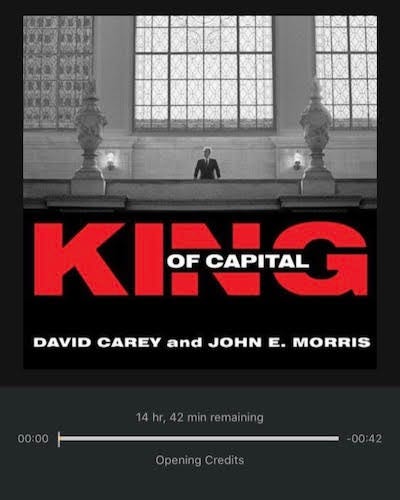King of Capital by John E. Morris and David Carey
2020, book #18: “In 1985, Peterson and Schwarzman partnered to create Blackstone. Peterson was Chairman and Schwarzman CEO.” — John Morris

Finished on March 18, 2020
Learning from everyone is something that I view as essential. One of my excellent mentors recommended this book to me after he started becoming more involved with venture capital. Since moving further into family offices, and institutional investing, the conversations have changed and he shared that many of his colleagues were referencing this book in conversation. He knew that this was a book I could learn from and greatly enjoy — I’m glad I worked through it.
I went through the book What it Takes by Stephen Schwarzman at the end of 2019. Was great to get a better understanding of who he was and what he built. I learned so much from that book and had to chalk it up as one of my all-time favorites. Stephen is someone that I have so much admiration and respect for now.
In 1985, Peterson and Schwarzman partnered to create Blackstone. Peterson was Chairman and Schwarzman CEO. They maintained their previous model with Peterson getting them in the door and Schwarzman, then 38, would make the deals happen. This is the way that they would get deal flow for M&A.
I think I may have been semi-aware of this but not super familiar. It’s something that I’ve heard about in the past but understanding exactly how it could be done was quite valuable.
When a company defaults on its debt, creditors can often swap that debt for equity when a company restructures.
The first rule of investing is don’t lose money. Steve, as one of the greats, certainly encompassed that.
Schwarzman always struggled with the idea of risking money to make money. Steve said in response that he doesn’t like failing and losing money is failing.
This was a crazy segment of the book for me. Seeing the path of LBOs (leveraged buy-outs) and the way that their perception changed was one thing but the impact and resulting effect was another completely. 20% of the LBO amount was needed at one point? I mean maybe it makes sense but in many cases that could be $2 billion for a $10 billion organization and that’s quite a sum of liquid cash.
LBOs attained such a tarnished reputation that they began to refer to such deals as private equity. During the late 80s, firms were regularly required to put up a greater portion of the buyout amount, now closer to 20% which resulted in not only lower value deals but less LBO deal frequency. Unfortunately, this did little to combat the stigma that LBOs faced during this time.
Another segment that was particularly interesting to me was the following. The trends and timelines piqued my interest.
The new business of less leverage and more equity began to emerge from hibernation in 1993 and 1994.
I gave this book a 4/5
Join my weekly newsletter to see all of my writing here.